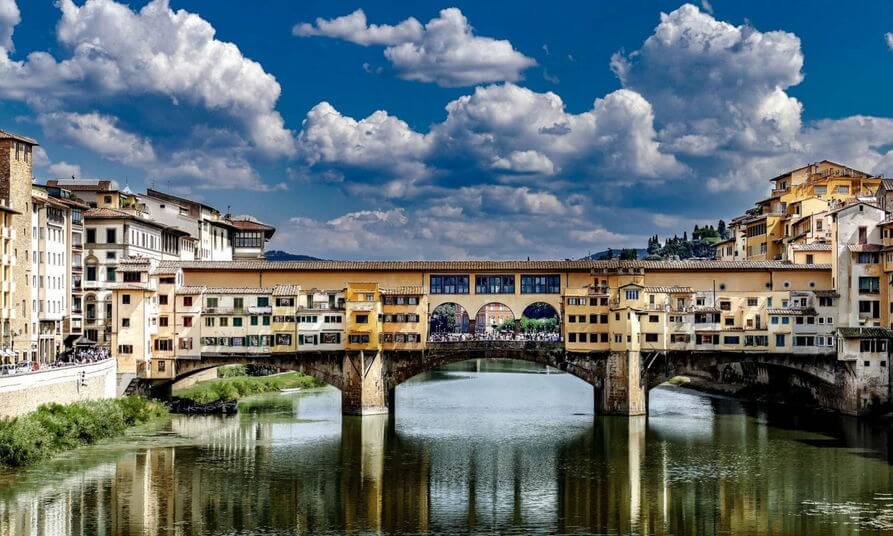A World Heritage Site is an area or landmark with legal protection under an international convention administered by the United Nations Educational, Scientific, and Cultural Organization (UNESCO). UNESCO designated World Heritage Sites for having historical, scientific, and cultural or other forms of importance.
The committees judge the sites. World Heritage Sites might be historical structures, ruins, buildings, lakes, forests, deserts, mountains, monuments, or wilderness areas. It signifies the remarkable achievement of humanity and protects from the damages.
Thus they save our planet by ensuring the protection of historical witnesses.
Italy has 54 UNESCO World Heritage Sites, covering around 5% of UNESCO World Heritage Sites around the world. No other country has as many World Heritage Sites as Italy.
A lot of historical places attract you more and more. Vatican City, St. Peter’s Basilica, Roman Forum, Grand Canal, Colosseum, and many more sites that will not be hopeless to you. It is the main reason why many people from various countries visit Italy every year. For married couples or single people, Italy is suitable for all to travel. Italy is the witness of the culture of the world. Here, we discuss the top 10 most visited World Heritage Sites in Italy.
Royal Palace of Caserta
The Royal Palace of Caserta is a former residence of the royal family. It is recognized as the triumph Barque of Italy. It is situated at Caserta in southern Italy. The House of Bourbon constructed it.
Kings of Naples, the king of Two Sicilies, used it for their residents. The Royal Palace of Caserta was considered the largest palace during the 18th century of Europe. Luigi Vanvitelli designed it following the wishes of Charles of Bourbon III.
Luigi Vanvitelli was one of the greatest architects of Italy in the 18th century. The Royal Palace of Caserta and Park was built with the combined influence of Rome, Versailles, and Tuscany. It covers over 11 acres with fountains, garden pools, and cascades.
UNESCO recognized the Royal Palace of Caserta as a World Heritage Site in 1997. The Royal Palace of Caserta is closed on Tuesdays. Other days, it is open. First Sunday of every month, entrance is free in the Palace, and the ticket price is reduced for the park. The best travel time is spring and summer.
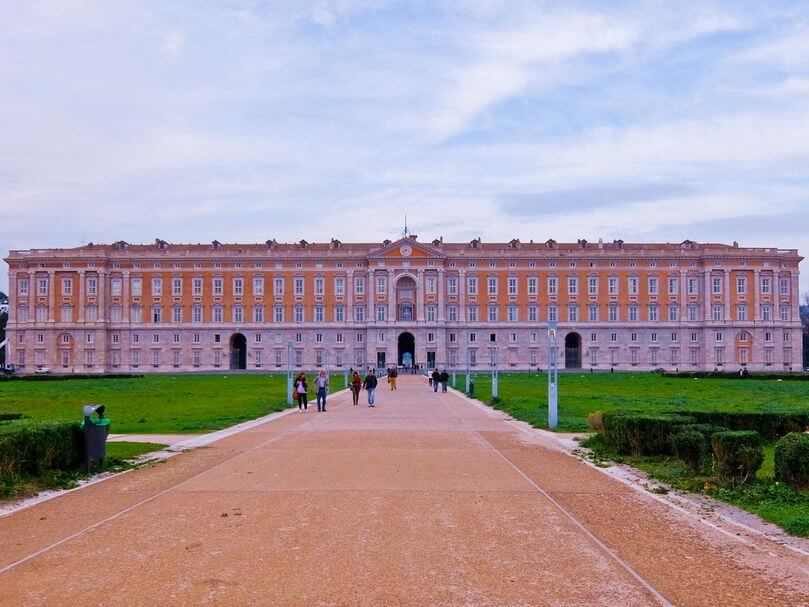
Image Source: thetravelmagazine.net
Short Information about Royal Palace of Caserta
- Type: Palace
- Architectural style: Baroque architecture
- Architects: Luigi Vanvitelli, Carlo Vanvitelli
- Construction started: 1752
- Address: Piazza Carlo di Borbone, 81100 Caserta CE, Italy
- Hours: 8:30 AM–7:30 PM
Arab-Norman Palermo and the Cathedral Churches of Cefalù and Monreale
Arab-Norman Palermo, the Cathedral Churches of Cefalù, and Monreale are situated in Palermo, the northern coast of Sicily. It is a group of nine spiritual and civic structures. This site was built during the era of the Norman kingdom of Sicily (1130-1194).
It is a blend of different structures such as Byzantine, Western, and Islam. This combination gives it a unique symbol that supports peaceful coexistence between people from different origins. (Muslim, Jewish, Latin, Byzantine, French, and Lombard)
Three churches, two palaces, a bridge in Palermo, a cathedral, and the cathedrals of Cefalú and Monreale built an illustration of a social-cultural syncretism among the Islam, Byzantine, and Western on the Sicily island that contributed to a rising new idea of structure, space, and decoration.
UNESCO had announced the Arab-Norman Palermo and the Cathedral Churches of Cefalù and Monreale is a World Heritage Site in 2015.
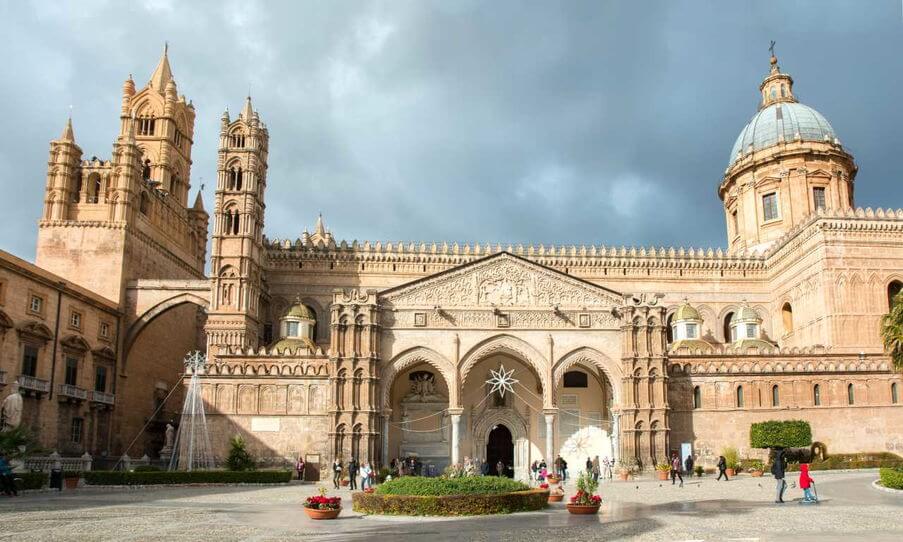 Image Source: govisity.com
Image Source: govisity.com
Short Information about Arab-Norman Palermo and the Cathedral Churches of Cefalù and Monreale
- Type: Religious and Civic
- Architectural style: Arab-Norman style
- Architects: Norman rulers
- Construction started: 1130-1194
- Address: Via Notarbartolo, 9 – 90141 – Palermo, Sicily, Italy
- Hours: 8:30 AM–7:30 PM
Basilica di Santa Maria Assunta, Aquileia
Aquileia was one of the wealthiest and largest cities of the Roman Empire. Attila destroyed this city in the 5th century.
Basilica di Santa Maria Assunta is an outstanding architecture with excellent mosaic pavement. It played a vital role in evangelizing central Europe.
Basilica di Santa Maria Assunta was dedicated to the saints Hermagor and Fortunatus and the Virgin Mary. Its development started after 313 AD. The Basilica di Santa Maria Assunta was affiliated with the Catholic discipline. The Christian community was built in the period of the Edict of Milan.
According to the Romanesque and Gothic styles, the imposing mosaic floor was dated back to the Theodorian church. It was built at the beginning of the IVth century. The Basilica di Santa Maria Assunta was rebuilt again between the 11th and 14th centuries.
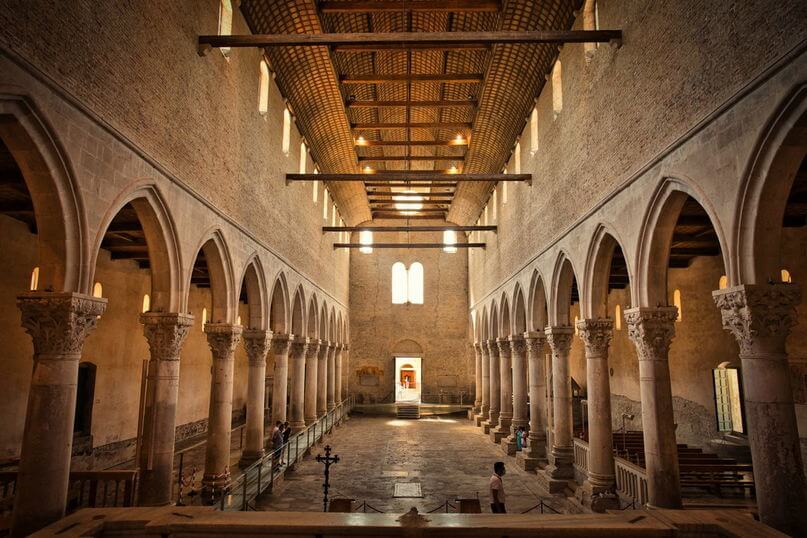
Image Source: travelinpink.com
Short Information about Basilica di Santa Maria Assunta, Aquileia
- Type: Church
- Architectural style: Romanesque architecture
- Architects: Patriarch Poppo
- Construction started: 11th century
- Address: Piazza Capitolo, 1, 33051 Aquileia UD, Italy
- Hours: 10AM–5PM
Valle Dei Templi
The Valle Dei Templi, or Valley of the Temples, is an archaeological site in Agrigento in Sicily. It is an example of Greek art and architecture.
Valle Dei Templi is the largest archeological park globally. It covers 1600 hectares, including the ruins of seven temples, the agora, city walls, an entry gate, and the Roman forum with sanctuaries and necropolis.
Akragas, the Greek colony, was developed in the 6th century BC. The Valle Dei Templi is one of the main attractions of Sicily. The construction of this ancient site is in several states, such as some parts are excellently preserved and some are severely eroded.
The most amazing site is the eroded site. It has endured for millennia. Cicero and Livy cited the city in ancient texts.
The Lower Agora included a gymnasium, shops, and a sacred area. The Upper Agora contained the public meeting place.
A Roman Forum was included when the Roman Empire conquered the Greek colonies. In 1997, UNESCO recognized it as the World Heritage Site.
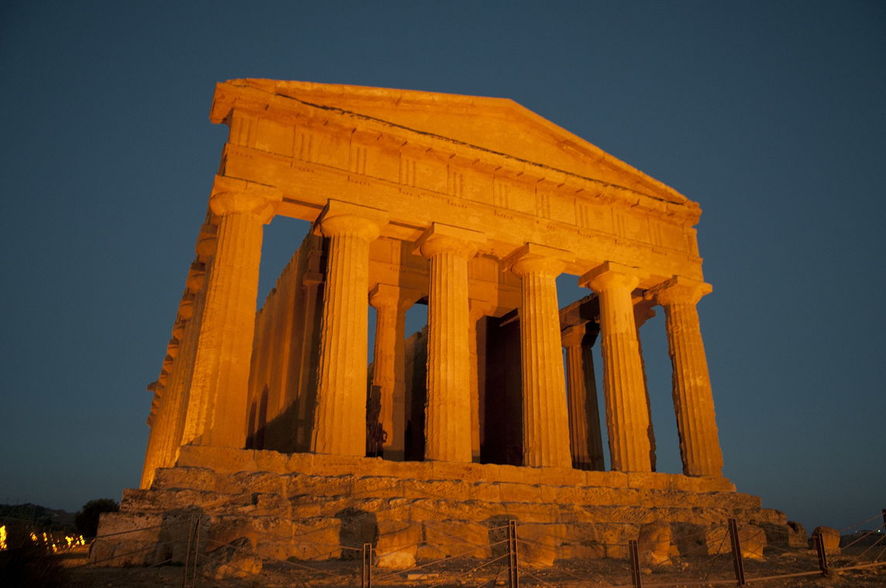 Image Source: wikimedia.org
Image Source: wikimedia.org
Short Information about Valle Dei Templi
- Type: Greek temples
- Architectural style: Greater Greece art and architecture
- Architects: Unknown
- Construction started: 440–430 BC
- Address: 92100 Agrigento, AG, Italy
- Hours: 8:30 AM–1:30 PM, 3–7 PM
Florence
Florence is a city of Central-Northern Italy and also the capital of the Tuscany region. It is one of the most populated cities in Italy. Florence was a center of trade and finance in medieval Europe. At that time, it was the wealthiest city.
Florence has been called “the Athens of the Middle Ages.” Florence is the birthplace of academics and scholars that contributed to the Renaissance. It was founded as a colony for the Roman military. Around the 1st century BCE, Florence city was founded. It had become a republic. From 1865-1870, Florence was the capital city of Italy.
It obtained preeminence in finance and commerce, learning, and arts. Florence city has numerous art galleries like the Palazzo Pitti and the Uffizi Gallery, and numerous museums. The dialect of Florence was formed from the standard Italian language. It was the language of culture in Italy. Dante Alighieri, Giovanni Boccaccio, Petrarca, Francesco Guicciardini, and Niccolò Machiavelli developed this dialect for holding its prestige. In 1982, UNESCO declared Florence as a World Heritage Site and the Historic Center.
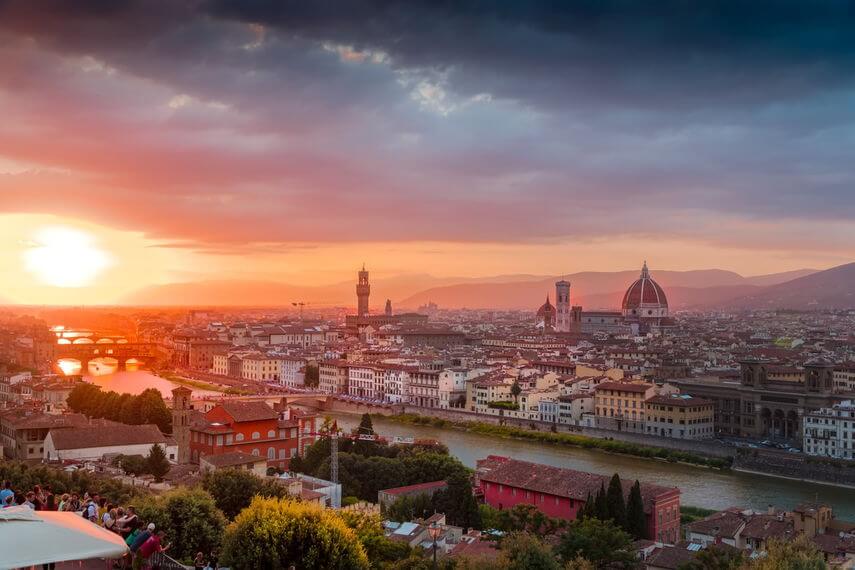 Image Source: legacy.travelnoire.com
Image Source: legacy.travelnoire.com
Short Information about Florence
- Type: City/Town
- Architects: Etruscans
- Construction started: 9th–8th century BC
- Address: Tuscany, Italy
Herculaneum
Herculaneum was an ancient town. This town is situated in Ercolano, Campania, Italy. It is the commune of modern Italy. Herculaneum town was buried under volcanic pumice and ash for the eruption of Mount Vesuvius in 79 AD.
Herculaneum town is named for Hercules, a Greek mythical god. According to the great historian Dionysius of Halicarnassus, Herculaneum city was built in 1243 BC. Some historical analysts said that this city was founded by the Etruscans or the Oscans in the 7th century BC. Romans dominated this city in 90 BC. They converted it into a municipium.
Herculaneum town reached its glory due to the city’s coastal location, mild climate, and clean air in the final years of the Roman Republic. For these reasons, it was a popular resort location. Roman patrician families lived there. Until the devastating earthquake struck in 62 AD, Herculaneum town was the most populated and vibrant city. In 79 AD, the eruption of Mount Vesuvius occurred. The city was covered with volcanic pumice and ash. As a result, the climate became toxic. People were wiped out from their inhabitants. In 1997, UNESCO declared the Herculaneum as a World Heritage Site and the Historic Center.
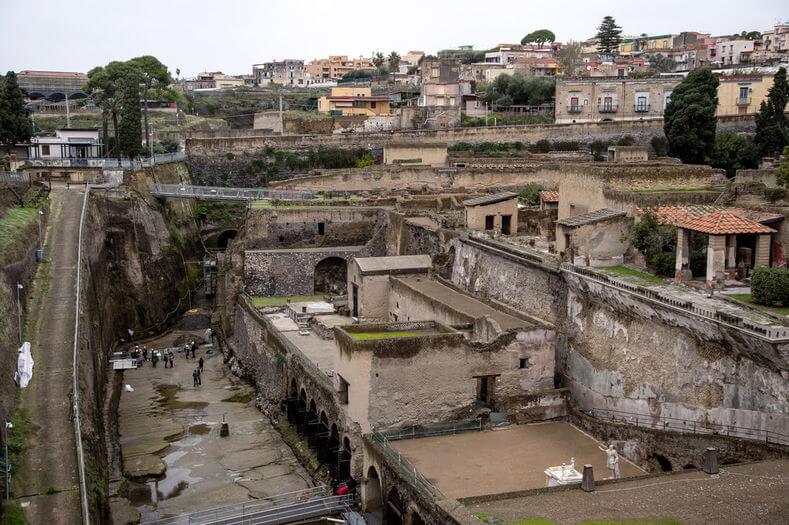
Image Source: nbcnews.com
- Type: Settlement
- Architects: Greek hero Heracles
- Construction started: 6th – 7th century BC
- Address: Ercolano, Campania, Italy
Pompeii
Pompeii is an archaeological site. It was an ancient city situated in the Campania region in southern Italy, near the Bay of Naples. Pompeii was the flourishing and sophisticated town of Roman civilization. Due to the devastating eruption of Mount Vesuvius in 79 AD, Pompeii city was buried under volcanic ash and pumice.
The ruins of Pompeii were first discovered in the late 16th century. Italian architect Domenico Fontana discovered the ruins of Pompeii. It was excavated in 1709. Visitors can explore the ruins of the houses and streets of the preserved site of Pompeii easily. Pompeii is significant evidence of Roman civilization. It looks like an open book providing exceptional customs, trade, and art of their past everyday lifestyle. The first inhabitant of Pompeii was the Neolithic population of Campania. Neolithic people spoke the Oscans or Osci language.
Neolithic people came into contact with the Greek people in the 8th century BC. Etruscans built the first settlement on the site of Pompeii at the end of the 7th century BC. They decreased the Greek influence on Campania. The Etruscans first built the city walls of Pompeii. It surrounded nearly 63 hectares of territory. Etruscans developed Pompeii city as a safe harbor for performing trade smoothly. In 1997, UNESCO declared Pompeii as a World Heritage Site and the Historic Center.
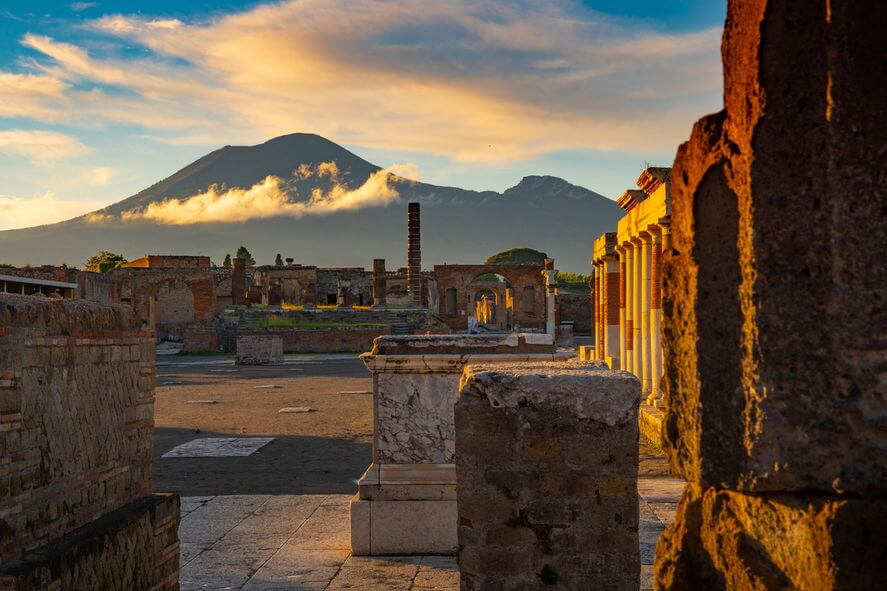 Image Source: cloudfront.net
Image Source: cloudfront.net
Short Information about Pompeii
- Type: Settlement
- Architects: Greek hero Heracles
- Construction started: 6th – 7th century BC
- Address: Ercolano, Campania, Italy
Piazza Dei Miracoli
The Piazza Dei Miracoli or The Campo Dei Miracoli, meaning the Square of Miracles in English. It is located in Pisa, Tuscany, Italy. Piazza Dei Miracoli is recognized as the most important center of European art.
It is one of the most magnificent architectural structures in the world. Piazza Dei Miracoli was a Catholic Church, considered most sacred by the Catholic Christian society. Four great religious edifices dominated this Square: the Pisa Baptistry, the Pisa Cathedral, the Camposanto Monumentale, and the Campanile, are situated there. It is also the site of the Ospedale Nuovo di Santo Spirito or New Hospital of the Holy Spirit, the Sinopias Museum, and the Cathedral Museum. Piazza Dei Miracoli first started taking shape in 1064 by creating the centerpiece of the whole complex.
The Cathedral part was dedicated to the Santa Maria Assunta. Pisan Romanesque architecture had been influenced during building the Cathedral with its stylish elements. In 1987, UNESCO declared the Piazza Dei Miracoli as a World Heritage Site and the Historic Center.
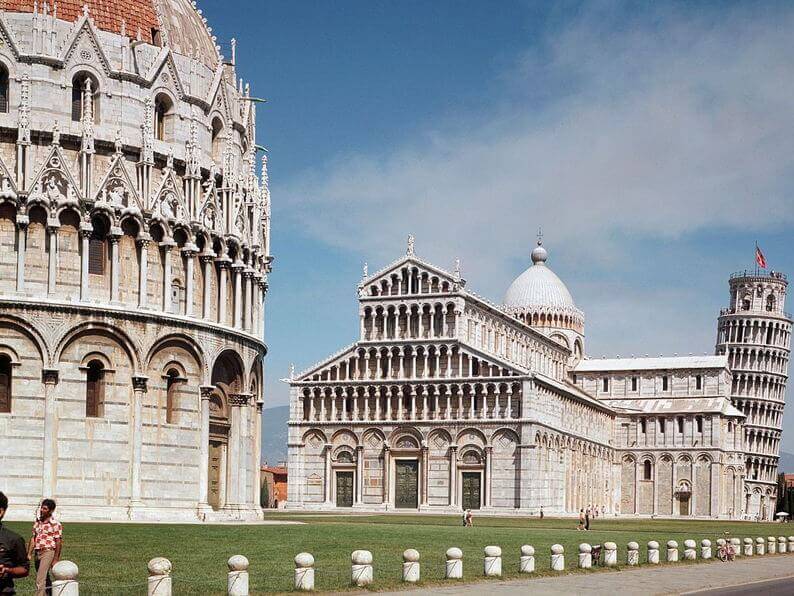
Image Source: hips.hearstapps.com
Short Information about Piazza Dei Miracoli
- Type: Catholic Church
- Architectural style: Pisan Romanesque
- Architects: Buscheto
- Construction started: 1064 CE
- Address: Piazza del Duomo, 56126 Pisa PI, Italy
- Hours: 9 AM–8 PM
Villa Romana del Casale
The Villa Romana del Casale is a large Roman palace. It is located in Piazza Armerina, Sicily. Villa Romana del Casale was a rich Roman mosaics collection.
It was built in the 4th century CE, for replacing smaller rustic residences. Roman provincial aristocracy owned this villa. After the fall of the Roman Empire, Villa Romana del Casale became fortified in the 5-6th century CE. The people of the villa were abandoned in the 13th century.
A small community was found and known as Casala over the ruins in the 15th century. Villa Romana del Casale is famous for its mosaic. Skilled African mosaic workers worked for it. They linked it to the cities of Hippo, Caesarea, and Carthage turned the Villa Romana del Casaleinto into one of the most outstanding testimonies of all African mosaic art. The Villa Romana del Casale is an example of a combination of both Late Antiquity and Roman culture. In 1987, UNESCO declared the Villa Romana del Casale As a World Heritage Site and the Historic Center.
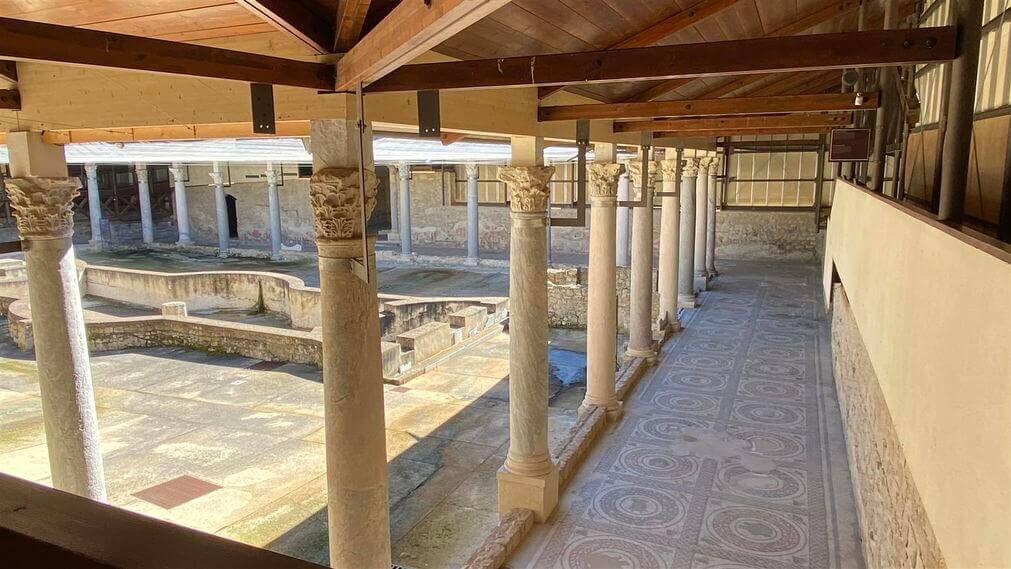 Image Source: villaromanadelcasale.it
Image Source: villaromanadelcasale.it
Short Information about Villa Romana del Casale
- Type: Roman villa
- Architectural style: Ancient Roman architecture
- Architects: Unknown
- Construction started: First quarter of the 4th century AD
- Address: SP90, 94015 Piazza Armerina EN, Italy
- Hours: 9 AM–6 PM, 8–10 PM
Cinque Terre
The Cinque Terre is a coastal village located west of La Spezia Province, northwest of Italy. It comprises five villages such as Vernazza, Corniglia, Riomaggiore, Monterosso al Mare, and Manarola. The coastline, the surrounding hillsides, and the five villages are all part of the Cinque Terre. It is a popular tourist destination.
People have built steep landscapes and terraces over the centuries. Cinque Terre was developed in the 11th century. Vernazza and Monterosso were the first to settle in this village. It was the territory of the Republic of Genoa.
The people of Cinque Terrebuilt a new defense fort for defending from the attack of Turk in the 16th century. Cinque Terre faced some economic recession in the 17th to 19th century. Their economy recovered due to building an arsenal in La Spezia. This arsenal contributed to building a railway link to Genoa. Since the 1970s, Cinque Terre has become a popular tourist zone. In 1997, UNESCO declared the Cinque Terre a World Heritage Site.
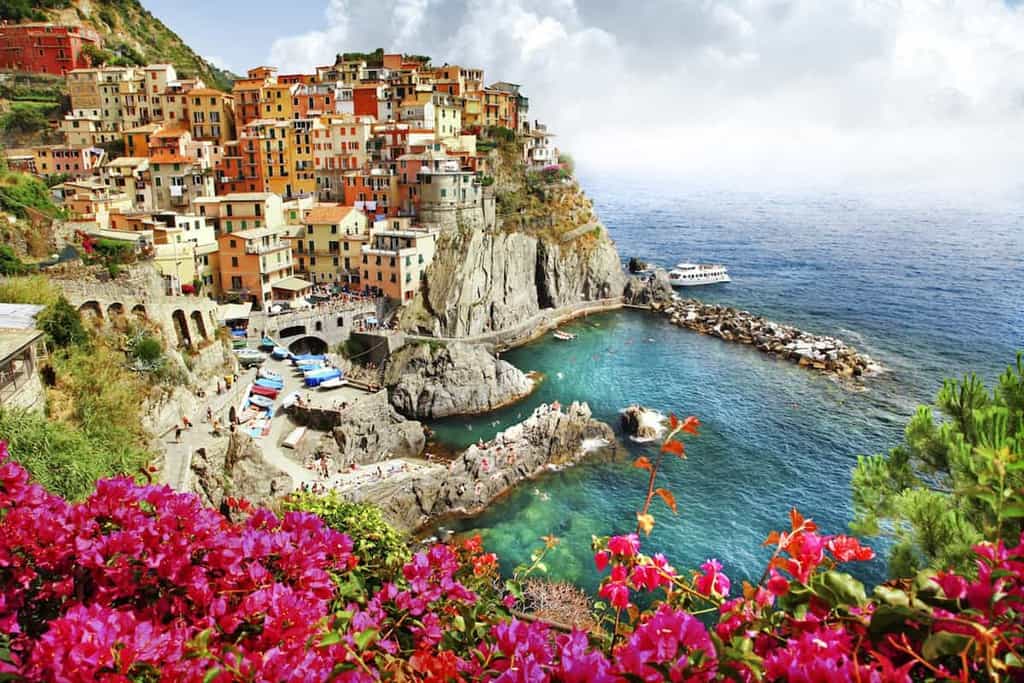 Image Source: coopculture.it
Image Source: coopculture.it
Short Information about Cinque Terre
- Type: Settlement
- Construction started: 11th century
- Address: Province of La Spezia, Italy
In this article, you can learn about the top-visited World Heritage Sites of Italy. Hopefully, it might help you to find the sites. Just don’t forget to buy a ticket from the Rome Tour Ticket before visiting.
Medicines are powerful weapons to fight against diseases.They can also be harmful if administered incorrectly.
The use of medications without lab tests has become a global phenomenon. This problem is getting worse, especially among the general public in developing countries like Bangladesh.
People are more reliant on pharmacies because of the convenience it provides. They can treat their common health issues like seasonal flus or headache in a short period of time. It is also cost convenient.
Alarmingly, this is the main reason why the use of non-prescription medications among the younger generations is on the rise.

